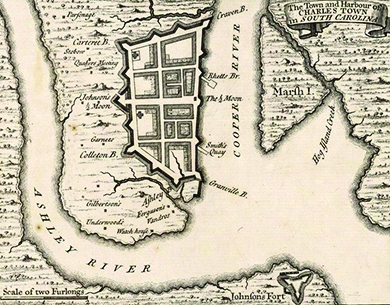| << Chapter < Page | Chapter >> Page > |
Charles II was committed to expanding England’s overseas possessions. His policies in the 1660s through the 1680s established and supported the Restoration colonies : the Carolinas, New Jersey, New York, and Pennsylvania. All the Restoration colonies started as proprietary colonies , that is, the king gave each colony to a trusted individual, family, or group.
Charles II hoped to establish English control of the area between Virginia and Spanish Florida. To that end, he issued a royal charter in 1663 to eight trusted and loyal supporters, each of whom was to be a feudal-style proprietor of a region of the province of Carolina.
These proprietors did not relocate to the colonies, however. Instead, English plantation owners from the tiny Caribbean island of Barbados, already a well-established English sugar colony fueled by slave labor, migrated to the southern part of Carolina to settle there. In 1670, they established Charles Town (later Charleston), named in honor of Charles II, at the junction of the Ashley and Cooper Rivers ( [link] ). As the settlement around Charles Town grew, it began to produce livestock for export to the West Indies. In the northern part of Carolina, settlers turned sap from pine trees into turpentine used to waterproof wooden ships. Political disagreements between settlers in the northern and southern parts of Carolina escalated in the 1710s through the 1720s and led to the creation, in 1729, of two colonies, North and South Carolina. The southern part of Carolina had been producing rice and indigo (a plant that yields a dark blue dye used by English royalty) since the 1700s, and South Carolina continued to depend on these main crops. North Carolina continued to produce items for ships, especially turpentine and tar, and its population increased as Virginians moved there to expand their tobacco holdings. Tobacco was the primary export of both Virginia and North Carolina, which also traded in deerskins and slaves from Africa.

Slavery developed quickly in the Carolinas, largely because so many of the early migrants came from Barbados, where slavery was well established. By the end of the 1600s, a very wealthy class of rice planters who relied on slaves had attained dominance in the southern part of the Carolinas, especially around Charles Town. By 1715, South Carolina had a black majority because of the number of slaves in the colony. The legal basis for slavery was established in the early 1700s as the Carolinas began to pass slave laws based on the Barbados slave codes of the late 1600s. These laws reduced Africans to the status of property to be bought and sold as other commodities.
Visit the Charleston Museum’s interactive exhibit The Walled City to learn more about the history of Charleston.
As in other areas of English settlement, native peoples in the Carolinas suffered tremendously from the introduction of European diseases. Despite the effects of disease, Indians in the area endured and, following the pattern elsewhere in the colonies, grew dependent on European goods. Local Yamasee and Creek tribes built up a trade deficit with the English, trading deerskins and captive slaves for European guns. English settlers exacerbated tensions with local Indian tribes, especially the Yamasee, by expanding their rice and tobacco fields into Indian lands. Worse still, English traders took native women captive as payment for debts.

Notification Switch
Would you like to follow the 'U.s. history' conversation and receive update notifications?